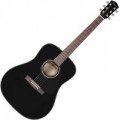Body
Guitar body construction, including both soundboards and sides. For these parts, two main types of wood can be used: solid (solid) and puff (better known as plywood). Plywood is cheaper than solid wood, but loses to it in terms of acoustic properties. Therefore, the type of deck in the characteristics is usually indicated only if solid wood is present in it. However, if data on the deck is not given, this does not mean that the instrument is made entirely of plywood; in addition, it is worth noting that some types of plywood come close to solid wood in terms of acoustic properties. Therefore, without having information on the deck design, it makes sense to focus primarily on the price category of the instrument.
Options for a solid tree can be as follows:
—
One piece top. The English name is also used — solid top. We are talking about instruments in which only the upper deck is made of solid wood — the rest of the body is made of plywood. This option is a good compromise between sound quality and affordable price, it is quite popular in mid-range guitars.
—
Completely whole. A body in which all parts are made of solid wood — both decks and sides. This is the most advanced option in terms of acoustics — especially since some types of wood even improve over time (provided that it is solid wood). However, a completely one-piece body is quite expensive, so this option is found
...mainly in high-end professional instruments.Case
The presence of a
case or cover in the tool delivery kit (what exactly is included in the kit must be specified in each case separately).
A case is called a case made of hard materials, a case is made of soft materials, this is the main difference between these types of accessories. Otherwise, they are similar: both the case and the cover are provided primarily for the convenience of transporting the tool. To do this, the design provides for handles, shoulder straps and other devices that facilitate carrying, as well as compartments for additional accessories (replaceable strings, tuners, etc.). However, it is desirable to store the tool in a case or case — to protect it from dust and other adverse factors.
The “native” case/case is good because it optimally fits a specific guitar model and is immediately sold with it, saving the owner from unnecessary searches. On the other hand, manufacturers often include the simplest types of cases in the kit, with minimal additional features and a very limited degree of protection. This is especially true for cases that can be made of thin material and are only suitable for short-distance movements in warm weather without rain. Therefore, sometimes it makes more sense to buy a case separately.
Strap
The presence of a
belt in the tool kit.
The strap allows you to hang the guitar on your shoulder. This not only gives the guitarist additional options when playing (for example, you can comfortably play while standing), but it can also be useful for transporting the instrument — you can hang it behind your back, freeing your hands (although in this case it doesn’t hurt to make sure the strap is secure). Straps are also sold separately, but the complete accessory, by definition, is optimally suited for the guitar, and besides, you don’t need to spend additional time and effort to buy it.
Tuner
A
tuner is included with the instrument. Note that in this case we are talking about a separate device; electro-acoustic guitars (see "Type") are usually equipped with a module built directly into the tone block, so this package is not relevant for them.
The tuner is designed to tune the guitar — more precisely, to facilitate tuning: it determines how the sound of each string corresponds to the reference note, and tells the guitarist about it. Note that the functionality of the tuners can be different, and the characteristics of the complete device in each case should be specified separately. So, the simplest models are initially "sharpened" for the standard six-string system and can only display the direction (higher or lower) of the string's sound differs from the standard one. These tuners are inexpensive, but only suitable for undemanding musicians. More advanced models can determine the sounding note and the specific frequency of the sound, indicate the degree of deviation from the standard; there are devices with the ability to change the key of the system or even the type of system. These features may come in handy for professional guitarists.
Picks
Picks included with the guitar.
The pick is a small plate that the guitarist uses to pick the sound from the strings. In this way, you can get a brighter, clearer and more sonorous sound than when playing with your fingers (both on notes and on chords); therefore, many musicians prefer to use picks.
Picks can vary in stiffness; The best option depends primarily on the preferences of the guitarist. Thus, guitars, if they are equipped with picks, then, usually, several at once — this allows the musician to choose the most suitable option.

